|
Data File Updated:
Wednesday, April 23, 2025
 The planet Seren is the capital of the Loroi sector of the same
name, and the headquarters for the largest section of the main
front facing the Umiak, known as the Charred Steppes. Before the
war, Seren was the jewel of the colonial Loroi empire, the cultural
and economic center of the Union's largest sector, and the powerbase for the
governor who eventually became Emperor Eighth Dawn. But after enduring a
siege that lasted two and a half years, Seren fell to the Umiak,
and remained under enemy occupation for six years. When it was
liberated in 2145, it had been mostly depopulated and much of
its useful infrastructure lay in ruins. In the decade and a half
since, the colony has been partially rebuilt to serve as a
functional sector fleet base, but today it is still sparsely
populated and limited in its influence. Seren is a story of two
worlds: what it had become, and what remains of that now. The planet Seren is the capital of the Loroi sector of the same
name, and the headquarters for the largest section of the main
front facing the Umiak, known as the Charred Steppes. Before the
war, Seren was the jewel of the colonial Loroi empire, the cultural
and economic center of the Union's largest sector, and the powerbase for the
governor who eventually became Emperor Eighth Dawn. But after enduring a
siege that lasted two and a half years, Seren fell to the Umiak,
and remained under enemy occupation for six years. When it was
liberated in 2145, it had been mostly depopulated and much of
its useful infrastructure lay in ruins. In the decade and a half
since, the colony has been partially rebuilt to serve as a
functional sector fleet base, but today it is still sparsely
populated and limited in its influence. Seren is a story of two
worlds: what it had become, and what remains of that now.
In 2160 CE, Seren is an important regional base, and together
with the Mosi system anchors the spinward line of the Steppes front. It
also serves as a forward operating base for the Imperial
government, since Azerein Greywind's flagship and personal
squadron spend much of their time in and around the Seren area. Azimol
and Nezel also have extensive Loroi fleet bases, but they are in
the Tinza sector and technically under Neridi management, and so
out of courtesy to the Neridi government, the Azerein's
flagship does not enter Tinza unless there is a crisis that
requires it.
Seren III
The Seren system primary is a young, hot orange star located
at the rimward and spinward edge of current Union territory,
bordering Historian space and the current Steppes front with the
Umiak Hierarchy. The outer solar system consists of a very large
Kuiper-like comet belt dotted with numerous small icy
dwarf planets that draw out complex patterns in the belt. The inner solar system consists of four planets:
three terrestrial worlds and Seren IV (Dirreshol)
a large gas giant many times the mass of Jupiter. The giant
planet has effectively cleared the orbital slots around it of
debris, and so the inner planets experience less meteor activity
than other systems of a similar young age.

(fig.1: Seren
system diagram.)
Seren III, the site of the main colony in the system, is a large mineral-rich terrestrial planet,16,580
km in diameter, with a surface gravity of 1.22g and a
single large moon. The planet is tectonically active, with
numerous geothermal fissures and periodic surface volcanoes. The
surface is extremely arid, with a few small dark seas and briny
lakes, which are often connected to geothermal geysers and
vents. The
thick nitrogen atmosphere (~1.6 atm at the surface) contains
little water vapor, but breathable levels of oxygen and carbon
dioxide, thanks to the native autotrophs. The trace elements of
the atmosphere form a perpetual natural smog, which gives the
world a hazy blue-gray cast. The days are short (17
hours), and there are modest seasonal changes over the long
orbital period of 1.8 Earth years (657 Earth days).
From its location at the rimward corner of Union territory,
the nearby Pleiades star cluster and its brilliant blue
reflection nebulae fill one-fifth of Seren's night sky. On a
moonless night, a location far from the urban centers offers a
spectacular view of the cluster and molecular cloud complex.
Mineral Forests of the Silver Gnomes
The native life is still primitive on this young planet. Most
of the surface is barren and lifeless: rough volcanic mountains
and valleys, interspersed with great salt flats. The small, dark seas
support primitive
photosynthetic microbial organisms similar to cyanobacteria at
the surface, and hydrogen-oxidizing thermophilic bacteria in the
depths where there are
geothermal vents. The brittle crust is criscrossed with numerous
deep fissures created by the chaotic tectonic activity, where
previously active geysers have gone dormant and dried out. In
these deep ravines live the tinaiges or "silver gnomes,"
the dominant form of native life. It is a symbiotic colonial
compound organism similar to a lichen, with a cyanobacteria-like
photosynthetic component that lives near the surface, connected
to a thermophilic fungus-like component that sends long chains
of filaments down deep into the fissures, sometimes for
kilometers, to sources of water and geothermal hydrogen. The
byproducts of these organisms' activity over time form vast
fan-shaped fields of mineral stromatolites, which fill the rift
and blossom out into the surface. Eventually, over hundreds or
thousands of years, the geothermal hotspot that powers the local
ecosystem shifts to another location, or the stromatolites
themselves clog up the fissure, and the vents become dormant.
The tinaiges dry out, sprout spore-disseminating bodies, and die out, leaving only the forest of mineral fan-shaped
blades. These mineral formations are a prospector's paradise,
rich in valuable industrial metals and rare earth elements, and
their exploitation formed the basis of the Seren colony's
wealth, which in turn built an entire frontier for the Loroi.
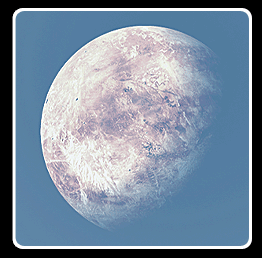 Menet,
the Sentry Moon Menet,
the Sentry Moon
Seren III has a single large moon (Menet, "rust"). It is
tidelocked to Seren, showing the same reddish face during its
entire orbital period of 49 Earth days. The airless surface is
tinted red by ferrous oxides which suggests a past hydrosphere,
made odder in comparison to its mother world's surface dominated
by copper and blue silicates.
Sometimes called the Sentry Moon, it hosts a wide range of
surface and orbital bases dedicated to directing the defense of
the system. Centered on Menet and Seren Citadel and
its network of satellite battle stations, this defense has been tried in fire
through numerous assaults and several changing of hands of the
star system, battered
down and rebuilt again and again.
The Fire Empire
A great rift valley just north of the equator is home to the
largest concentration of Loroi settlement on the planet. Named
Leinazeras, or "Fire Empire," it rings one of the largest
of the small seas on the planet, and contains a
habitation-friendly mix of periodically-flowing rivers and the
soil they bring down from the mountains, active geothermal
fissures, and kilometer upon kilometer of extinct stromatolite
mineral forest, ripe for harvesting. The barrier mountains bring
regular seasonal rains, though the rivers and lakes are mostly
empty by the end of the dry season. There are Loroi-edible
fungoids growing on the banks of the rivers during the wet
season, and year round in the many caves all over the fractured
landscape. The Loroi constructed aqueducts and cisterns to
support the farming of misesa and other imported crops,
but much of these have crumbled in the long disuse since the
occupation, and today remnants can be found growing sparsely
near permanent bodies of standing water. Seawater is far too
saline to support transplanted fish, but the seawater is itself
a commercial source of valuable salts. Water from deep wells is
hard with minerals, but potable.
Leinnazalat, Capital City of a Frontier Sector
"Fire City" is the largest urban center in the valley and
on the
planet. It establishes the prime meridian for Seren geography, and
functions as the capital of the province, the planet, and the
sector. It centers around the large spaceport and the even
larger ore processing facilities of the Smelter (Tobesadi),
the heavy industrial sector where stromatolite ore is processed
and either supplied to the local manufacturing hubs, or
transported via the spaceport up to the Seren's shipyards, or
out to the sector and Union beyond. The San Francisco of its
day, the stromatolite gold rush drove emigration to the
frontier, development of industry and infrastructure, and
eventually secondary colonization further into the Steppes.
Leinnazalat became a city of influence, fashionable architecture
and a new frontier culture. Seren grew into a "Fifth Sister
World" to rival the original three.
The
city was mostly evacuated during the long siege by Umiak forces,
and was captured largely intact and deserted when the system
fell. During the occupation, the few remaining Loroi in the
Leinazeras region were rounded up by the Umiak and put to work
in the Smelter. Much of the city was destroyed in the fall of
the Great Lift (see below) and in the subsequent Umiak
reprisals, and thereafter the Umiak killed any Loroi they could
find in the remains of the city.
Since liberation, small sections of Leinnazalat are still in
the process of being rebuilt, to support the reactivation of the
system's defenses and the region's resourcing and manufacturing
capability. But it is still mostly a ghost city, cowering under
the skyline of the crashed Lift and the old city's ruins.
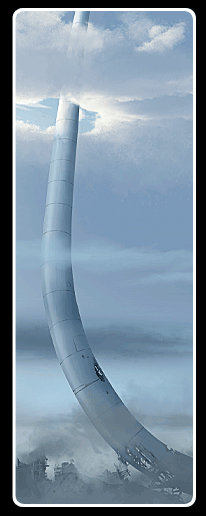 The Great Lift and the Silver Gate The Great Lift and the Silver Gate
Dirred Lagisimon "The Great Ore Lift" or
just "The Great Lift" was the engineering wonder of Seren; an
orbital elevator constructed to cheaply ferry the planet's ample
resources into geostationary orbit. It rises from moorings on
Forge Peak just south of Leinnazalat's city center to a mooring
point in geostationary orbit, and terminates in a long
counterweight that extends farther beyond. The mammoth structure
consisted of an outer sheath to protect the interior from
orbital debris, surrounding a set of multiple hoist cables
constantly running cargo cars from surface to orbit and back
again. The top of the lift was moored to Tintarral
Starport, the "Silver Gate." In addition to extensive port
facilities, Tintarral was a hub for several large shipyards
(both attached and in trailing or leading nearby orbits) which
provided a substantial portion of the Union's shipbuilding.
Tintarral was a gateway both for arriving immigrants from the
old world, and as a jumping off point for colonists bound for
destinations farther into the Steppes, and for traders coming
and going anywhere in between.
The Great Lift was still in use ferrying the last of the
evacuees from the surface when the Umiak forces broke through to
the planet's vicinity. The fleeing Loroi fleet commander could
not bring herself to destroy Seren's symbol of national pride
(to say nothing of the evacuees still aboard or clustered near
the base of the lift. Therefore the Umiak captured the entire
system intact, and began promptly using the starport as a
makeshift fleet base, and put the lift into operation in the
extraction of Seren's wealth for their own war effort.
The shipyard facilities in and around Tintarral were a
favorite target of those Loroi partisans who were still
operating against the occupation. These efforts were effective
enough that the Umiak commanders decided that the captive Loroi
on Seren were more trouble than they were worth, and took steps
to liquidate them. When the Loroi resistance got wind of this,
they preemptively launched every operation they had planned,
including a focused attack on the starport. The partisans
succeeded in detonating the reactors on one of the docked
warships, destroying much of the station and ripping it free of
its moorings to the Great Lift, which immediately began a slow
fall toward the surface. Quick Umiak action arrested the fall by
extending the counterweight, but the damage had been done; more
than a kilometer of the elevator outer structure had been
dragged to the ground, destroying much of the city. The Lift
remains aloft, but unusable.
Seren Citadel
Though the remains of the Silver Gate still remain in orbit,
its function as primary starport and fleet base has been
replaced by the new Seren Citadel, built to replace earlier
iterations of battle stations that were destroyed during the
fall of Seren to the Umiak. The current Seren Citadel is the
largest battle station in the Loroi Union, and it is hub of a
network of battle stations and defense bases arrayed throughout
the system. The Citadel is normally parked in geostationary
orbit over Leinnazalat, so that it can function as a shuttleport
for easy access between surface and orbit, but it is capable of
moving to wherever it is needed. It contains modest port and
shipyard facilities, protected within its formidable defenses.
The orbital defense network around Seren also includes a trio
of Type-3 battle stations (usually flanking the Citadel) and an
array of automated defense satellites. Defense of the system is
coordinated at the Citadel through the defenses on the Sentry
Moon and throughout the system, and any fleet elements present.
History
of the Colony
The Seren system was first utilized as an exploration outpost
by Loroi scouts in the latter part of the 1600's CE. Seren III
was formally chartered as a colony in 1710, during the era of
Azerein Swiftsure's administration. The planet's mineral wealth
together with its ideal location at the frontier of a new and
expanding sector and as a jumping-off point into the Steppes
region drove rapid growth in the colony and the system's
infrastructure. This growing affluence also helped to drive the
development of the nearer unclaimed portions of the sector, including the inhabited Halli and Golim-chei systems. By
1790, Seren had become known as the "Sapphire of the Steppes,"
the influential and wealthy capital of the largest
Loroi-controlled sector in the Union.
Seren Culture
Much of the Loroi immigration flooding into the Seren Sector
and the Steppes came not from the original three Sister Worlds,
but from Maia and the other earlier established Loroi colonies.
As such, many of the colonists had never lived under the old
order, and a new culture began to take root in the new
institutions being built in this new frontier, which lacked the
rigid conservatism of the Splinter Colonies. Ancient clan
affiliations became less important. The Seren sector colonies
were among the first to follow examples set by the Neridi and
Barsam, to deregulate the traditionally mercantilist Loroi
economy within the sector. This new expansive optimism was
widespread across the new frontier, but it became identified
with the culture of Seren.
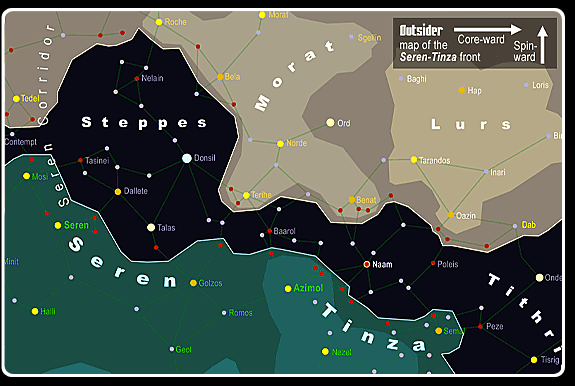
The Neridi Succession Conflict: 1790-1795
Under
the reforms of Azerein Swiftsure, intended to restore the
republican values of the pre-Imperial era, regional governments
were empowered with unprecedented authority for self-government.
As the central government abdicated more and more authority to
local administration, sector governors began to rise in power
accordingly, and increasingly frontier colonies began to look to
the sector capitals for aid and guidance instead of to Deinar.
The new Loroi colonies in the Steppes were in particular tied
closely with Seren and its governor, Eighth Dawn. Even when
disputes between local officials were escalated to the Imperial
government, increasingly they were sent back down to the sector
level for resolution. This led to rising tensions between
rival interests, especially on the frontier, as unresolved
disputes festered. Eighth Dawn continued to add new Steppes
colonies into the ever-growing sector under her control,
swelling the sector until it was almost twice the size of any
other, and despite complaints from other regional interests and
Axis republicans within her own administration, Swiftsure
declined to intervene. As tensions over unresolved disputes
continued to grow, in 1790 the order finally ruptured: in a
Neridi dispute over royal succession, Eighth Dawn's and Swiftsure's administrations each backed different claimants.
Swiftsure chose that moment to finally exert her authority, but
Governor Eighth Dawn openly defied her ruling, and continued to
back her preferred Neridi claimant.
What followed was a five-year "cold war" of armed standoffs
between the Frontier and Imperial fleets along the shared border
in Neridi territory (the Tinza Sector). The rival Neridi
claimant backed by Eighth Dawn had set up her own capital and
shadow government at Nezel, in opposition to the traditional capital at Derro. The
two Loroi factions mostly broke along cultural lines, with the
Loroi Seren and Mannad sector forces siding with Eighth Dawn, the
Loroi Minzan
and Maiad sector forces backing Azerein Swiftsure, and the
Neridi and Tinza split down the middle. A few
incidents did flare up into actual violence, but these were
mostly covert or though proxies, and did not break the
fragile peace. Ultimately, in September 1795 Swiftsure decided to
break the deadlock by gathering her forces and moving on Nezel
to depose the rival claimant, and Eighth Dawn's forces
intercepted the loyalists at Juka. For a moment it looked as if
there would be a bloody battle, but the Maiad and Tabenid
components of Swiftsure's fleet abruptly switched sides. This
set off a chain of defections, and Swiftsure was forced to
surrender. Eighth Dawn then took her fleet to Deinar and
petitioned the Diadem to appoint her Azerein, which they
promptly did.
With its former governor now proclaimed Emperor, Seren only
continued its rise in influence. Eighth Dawn's administration
advocated expansion in all sectors; this program was most
productive in the Seren, Tinza and Maiad sectors over the coming
centuries.
The agreement that ended the crisis ceded some of the jointly
held Seren sector territory to Neridi control, including Nezel
and Azimol. Eighth Dawn's administration saw a long period of
continued expansion of both the Seren and Tinza sectors. The
Neridi annexed all of the unclaimed territory right up to the
Morat and Lurs frontiers, while the Loroi colonized every viable
system through the gap between Morat and Historian territory, as
far spinward as Laisas at the Tenuki border. Loroi Farseers had
been aware for some time that unfamiliar alien populations
existed spinward of Tenuki territory for as far as could be
detected, and the Loroi were eager to contact the civilizations
of that region and the lucrative trade which they undoubtedly
represented.
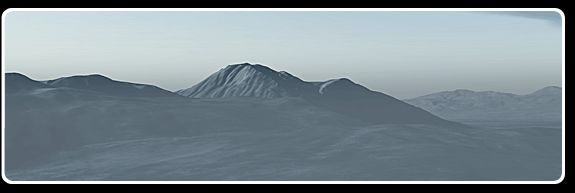
Outbreak of War with the Hierarchy and the Siege of Seren
Union scouts had made preliminary contact with the Lurs
civilization before the turn of the 22nd century, but the Lurs
refused formal relations. Trade with the Lurs was only permitted
through Morat intermediaries; the Morat traders would say only
that the Lurs nation was a protectorate under a larger spinward empire.
At the start of the 2100's a similar situation occurred during
early contact with the Tenuki; Union scouts were warned away
from the Tenuki frontier. In 2110, after repeated pressure by
Union traders for help in establishing formal trade relations
with this distant empire, Morat diplomats were finally able to
arrange a formal meeting between Union officials and
representatives of the Tenuki, Lurs, and their suzerain, the
Umiak Hierarchy of Principal Committees, Administrative
Assemblies, and Contributing Accessories. Despite a difficult
language barrier, talks seemed to go well, and agreements were
signed to allow formal trade. But Union traders were only
allowed at a small number of designated border system ports; no
Union vessels were allowed deeper into Hierarchy territory.
Without warning, in 2135 the Hierarchy launched a massive
invasion of the Union frontier colonies in the Steppes. The
unprepared Loroi fleets were caught completely off guard, and
their somewhat outdated weaponry was no match for the
numerically superior Umiak or the damage their plasma weapons
could inflict at close range. The Umiak penetrated quickly into
Loroi territory, driving the Tinza fleets back to Azimol, and
isolating the Loroi steppes spinward of Mosil. An abortive Loroi
counterattack through Morat territory failed, and Umiak fleets
began assaulting systems surrounding Seren itself.
For the next three years, Seren was the focus of a relentless
series Umiak assaults down the Seren Corridor from occupied
Tedel, and attempts to outflank Seren on the coreward side.
Utilizing the advantages of their Farseers to interdict
approaching fleets with their fast groups and to concentrate
their heavier fleet elements at the point of attack, Seren
forces held the line firmly. But they were doing so at great
cost, and the attrition was taking its toll... while the Umiak
showed no sign of running short on reinforcements despite the
horrific losses inflicted on their fleets. During this long
siege, the Seren system itself came under direct attacks, and so
steps were taking to start evacuating the civilian population to
Halli and Begalona.
In 2139, Hierarchy forces launched a new invasion of
Historian space. Historian forces offered little resistance to
the invasion, falling back from systems that had already been
evacuated. With its rimward flank now exposed, the defense of
Seren became untenable. The Sector commander gave the order for
the fleet to abandon the system on June 30, 2139.
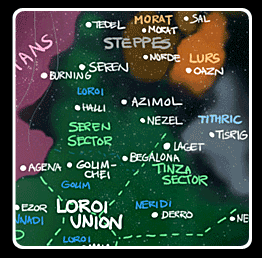 Hierarchy Occupation: 2139-2145 Hierarchy Occupation: 2139-2145
When Loroi forces withdrew from the Seren system, the
evacuation of civilian and support personnel was incomplete, and
some 50 million Loroi remained on Seren when the Umiak took
control of the system. These were all
females, mostly civilian. No known males were captured, having
long since left the system. Included among those trapped were a
few military ground units supervising the evacuation, and a
number of children. Despite priority given to children and
pregnant females during the evacuation, a small number failed to
evacuate in time, the largest group of these being diral
students who had been in the wild and out of contact. There were
no males among the Loroi captives.
With the planetary government already having fled, there was
no formal surrender or centralized command for resistance. There
was only sporadic fighting from the minimal Loroi military
ground presence as Umiak invasion forces occupied the major
cities. Some of these Loroi troops were killed during the
fighting, a few surrendered, and the rest fled into the
countryside. The Umiak quickly secured control of all the
major population centers and confined the Loroi captives into
what would eventually be transformed
into huge prison compounds. In short order, the Umiak put the
Loroi captives to work, mainly in reviving and operating Seren's resource extraction operations. The work regimen was
harsh (as it typically was for all planets under direct Umiak control), and Loroi of
all ages were required to work. Within the first year, the Umiak
liquidated most of the military prisoners, realizing that they
could not be securely confined.
Seren's geography, especially its mineral forests and the
network of caverns provided excellent cover for partisan bases outside of
the urban areas, even against Umiak ground-penetrating radar and
infrared sensors. Low-level resistance began immediately by the
Loroi forces dispersed in the foothills and caverns, including
the remnants of the ground units and even a few diral
bands that had not returned to the population centers to be
captured. The resistance forces included small numbers of Teidar
and Mizol, who could conduct sabotage operations right under the
very noses of the occupiers, evade capture, and blend in among
the among the civilian prisoners despite extensive electronic
monitoring. Seren's shipyard facilities, captured more
or less intact by the Umiak, were a particular focus of partisan sabotage
attempts. In the early stages of the occupation, these
resistance efforts were entirely local, as there was no central
control or any contact with the outside Loroi chain of command.
During the whole period of the occupation, Loroi prisoners
were frequently made the subjects of intense medical experiments
by the Umiak, who were very eager to learn how Loroi telepathy
worked, and hoped that large-scale experiments could reveal what
smaller scale examinations of earlier captives had not. These
experiments met with only limited success in terms of Umiak
knowledge of telepathy, and the program resulted in one of the
most damaging incidents of the occupation to that point, when a
group of young Loroi research subjects who were being studied
for operant psychokinetic abilities rebelled and destroyed the
entire research facility, and then rampaged through the nearby
internment compounds, freeing fellow prisoners. Most of the
escapees were eventually recaptured or killed, as they had all been tagged
with various tracking measures, but a few remained at large, and
are presumed to have joined the Loroi partisan forces in the
countryside.
This incident brought into sharp focus for the local Umiak
commanders what had been a slow realization: that the Loroi
population of Seren could not be effectively pacified in
anything like a predictable short term. It was at this time, two
years into the occupation, that the directive was issued to
begin the liquidation of the remaining Loroi captives on Seren
and throughout
the Steppes region.
On Seren, the Loroi partisans had learned of this directive
even before the mass executions started, and the disparate
resistance groups simultaneously and hurriedly went ahead with
any and all planned operations that were within their
capabilities. These included direct attacks on the interment
compounds and infrastructure under Umiak use. The most dramatic of
these sabotage efforts was the attack on Tintarral starport,
which severed the connections of the Great Lift at both ends and
caused its partial collapse and the destruction of much of the
capital city.
The Umiak accelerated liquidation efforts and dealt with the
Leinazeras uprisings through orbital strikes, destroying most of
what remained of the urban centers. The escape of large numbers of
prisoners afforded a short term tactical advantage to the Umiak
occupation forces, as they were easily tracked and could be used
as bait to ambush units of the Loroi resistance as they
attempted to rescue the escapees. However, despite the
successful extermination of some 90% of the remaining Loroi
population on Seren, including catastrophic losses among the
resistance forces, Seren was still not pacified. More than half
a million Loroi were still dispersed throughout the countryside,
and all of them involved in some way or other with the
partisans.
Over the last three years of the Umiak occupation of Seren, a
savage guerilla war was waged between the Umiak and the
surviving Loroi. Umiak occupation forces had been released from almost any
restraint in the hunting down and extermination the remaining
Loroi, but the surviving Loroi partisans had similarly been released
from any concern over reprisals against captive Loroi. Though
Loroi partisans were constantly being reduced in number (while
the Umiak casualties were replaced), resistance activities had
largely brought the Umiak resourcing operations to a halt. Umiak
casualties mounted with very little to show for their efforts,
and some of the partisan fighters gained a fearsome reputation
among the occupation forces.
Liberation and Reconstruction: 2145-2160
The Seren system was recaptured by the Loroi in 2145 when the Semoset
Offensive pushed the Umiak lines back
into the Steppes. The occupation had lasted 6 years, and in that
time roughly 49 million Loroi had been exterminated by the
Umiak. Perhaps surprisingly, the Umiak evacuated Seren almost
completely and did very little to destroy the remaining surface
or orbital infrastructure; it seems likely that they may had
expected to reoccupy Seren in the near term. But the damage to
Seren's infrastructure from occupation, resistance and
retaliation had been substantial, and the Umiak did leave
some terrifyingly altered and boobytrapped former Loroi
prisoners. The Loroi liberation forces quickly learned the
necessity to quarantine the 600,000 survivors on Seren pending
processing to make sure that they had not been tampered with by
the Umiak (sometimes, sadly, in the same internment facilities
in which they had been kept during the occupation). Many of the
resistance groups were so dispersed and well-hidden that it took
more than a year to contact them all and bring them back into
the fold of Loroi civilization. Some of the former resistance
fighters required extensive psychological therapy, and not all
of the treatments were entirely successful.
To be continued...
See also:
Loroi,
Loroi Sister Worlds,
Loroi
Timeline,
System
Defenses, History of the War
|
![]()
![]()
![]()
![]()



 Menet,
the Sentry Moon
Menet,
the Sentry Moon


